Ivory carved tusk depicting Buddha life stories
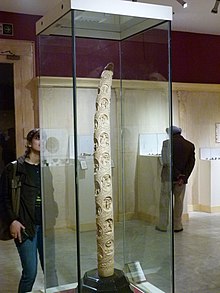
Carved elephant tusk depicting Buddha life stories is an intricately carved complete single tusk now exhibited at the Decorative Arts gallery,[1] National Museum, New Delhi, India. This tusk was donated to the Museum. This tusk, which is nearly five foot long, illustrates forty three events in the life of the Buddha and is thought to have been made by early 20th century craftsmen from the Delhi region.[2]
Description
The use of the complete ivory tusks for carving was popular in 18th and 19th century India, particularly in the Delhi region apart from Burma. Similar whole tusk carvings are also found in the Ivory Coast, Congo[3] and Benin but made from the tusks of African elephants.
The art of ivory carving in India is very ancient with references found in Kalidasa's Meghadūta. The earliest ivory carving from the Indian region is comb dating to the 2nd century CE found at Taxila. Ivory carving flourished in Assam and Mysore where elephants were available and the art of ivory carving had royal patronage. Ivory was an object of trade between kingdoms and they found their way into areas where the art of carving had patronage.[4]
This ivory tusk illustrates important life events of Buddha in 43 circular roundel, first 25 referring to the story of Buddha's birth to his enlightenment followed by 18 depicting his life events from enlightenment to Mahaparinirvana. Similar scenes have been presented in sculptures and paintings many a times but this ivory tusk shows few new scenes of Buddha's life such as Siddharatha's fight for a bird, his move against animal sacrifice and realization of death. As the thickness of the tusk reduces upwards, one can see at the tip three well-known postures depicting Bhumisparsha mudra, Abhayamudra and Dharmachakrapravatan mudra besides the roundels. There is also an intricately carved floral creeper banding around the roundels enhancing its beauty.
Scenes
The story runs from bottom to top and is arranged clockwise.[5]
Pre Enlightenment Life Events of Buddha
-
 Depiction of Kapilavastu, where prince Siddharatha lived The first roundel shows mountains, flora-fauna and architecture which gives the impression of a town probably Kapilavastu.
Depiction of Kapilavastu, where prince Siddharatha lived The first roundel shows mountains, flora-fauna and architecture which gives the impression of a town probably Kapilavastu. -
 Seated figure of King Suddhodana The father of Siddhartha, King Suddhodana of Kapilavastu has been shown seated on his throne.
Seated figure of King Suddhodana The father of Siddhartha, King Suddhodana of Kapilavastu has been shown seated on his throne. -
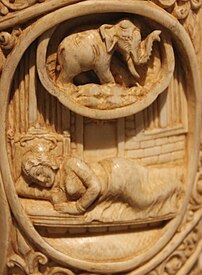 Dream of Queen Mayadevi The mother of Siddhartha, Queen Mayadevi is having a dream of an elephant which symbolizes the saintly soul's appearance in her womb.
Dream of Queen Mayadevi The mother of Siddhartha, Queen Mayadevi is having a dream of an elephant which symbolizes the saintly soul's appearance in her womb. -
 Mayadevi visiting her parents
Mayadevi visiting her parents -
![Mayadevi with her son Siddharatha This scene depicts the birth of Siddhartha, Prince of Kapilavastu in a different manner from other literary and sculptural narrations. Here Queen Mayadevi is shown seated with a baby in her lap surrounded by cauri-bearer and friends.[6]](//upload.wikimedia.org/wikipedia/commons/thumb/5/56/Maya_Devi_with_her_son_Siddhartha_Roundel_6_buddha_ivory_tusk.jpg/209px-Maya_Devi_with_her_son_Siddhartha_Roundel_6_buddha_ivory_tusk.jpg) Mayadevi with her son Siddharatha This scene depicts the birth of Siddhartha, Prince of Kapilavastu in a different manner from other literary and sculptural narrations. Here Queen Mayadevi is shown seated with a baby in her lap surrounded by cauri-bearer and friends.[6]
Mayadevi with her son Siddharatha This scene depicts the birth of Siddhartha, Prince of Kapilavastu in a different manner from other literary and sculptural narrations. Here Queen Mayadevi is shown seated with a baby in her lap surrounded by cauri-bearer and friends.[6] -
 Sage Asita visiting King Suddhodana
Sage Asita visiting King Suddhodana -
![Mayadevi's death scene[7]](//upload.wikimedia.org/wikipedia/commons/thumb/c/cf/Maya_Devi_on_her_death_bed_with_Suddhodhana_Roundel_8_buddha_ivory_tusk.jpg/214px-Maya_Devi_on_her_death_bed_with_Suddhodhana_Roundel_8_buddha_ivory_tusk.jpg) Mayadevi's death scene[7]
Mayadevi's death scene[7] -
 Prince Siddhartha in a garden
Prince Siddhartha in a garden -
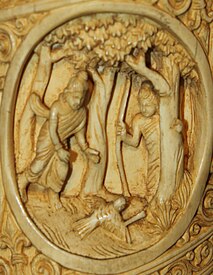 Siddhartha and Devadutta with a wounded bird
Siddhartha and Devadutta with a wounded bird -
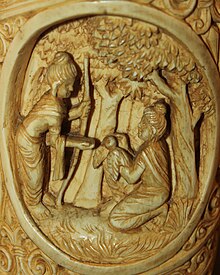 Siddhartha tends and cures the bird
Siddhartha tends and cures the bird -
 Siddhartha as an archer in the Swamvara of Princess Yasodhara
Siddhartha as an archer in the Swamvara of Princess Yasodhara -
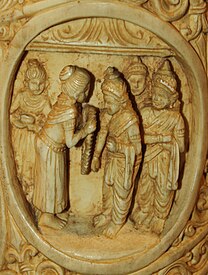 Yasodhara garlanding Siddhartha
Yasodhara garlanding Siddhartha -
 Siddhartha meets an old man
Siddhartha meets an old man -
 Siddhartha sees a corpse
Siddhartha sees a corpse -
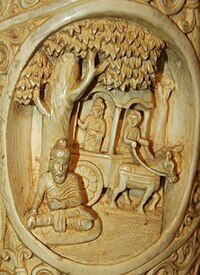 Siddhartha sees a meditating ascetic
Siddhartha sees a meditating ascetic -
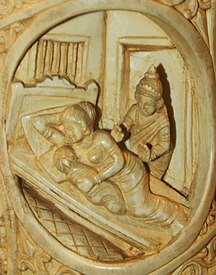 Siddhartha leaves his sleeping wife and sons
Siddhartha leaves his sleeping wife and sons -
 Siddhartha with his assistant Chandaka leaving the Palace
Siddhartha with his assistant Chandaka leaving the Palace -
 Siddhartha cuts his hair and removes his jewellery and royal costume
Siddhartha cuts his hair and removes his jewellery and royal costume -
 Siddhartha receives bhiksha from a woman
Siddhartha receives bhiksha from a woman -
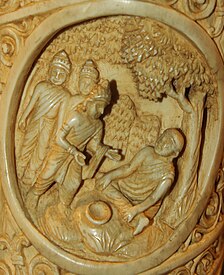 Siddhartha in Meditation
Siddhartha in Meditation -
 Five saintly persons visit Siddhartha while he meditates
Five saintly persons visit Siddhartha while he meditates -
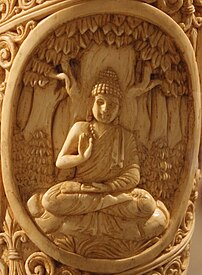 Buddha seated under a tree in Abhayamudra
Buddha seated under a tree in Abhayamudra -
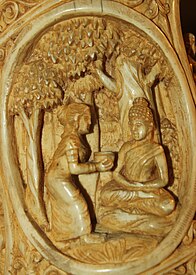 Sujata offering kheer to Buddha
Sujata offering kheer to Buddha -
 Māra tries to disturb and divert Buddha: Māra, the powerful demon arrives with the aim of preventing the Bodhisattva from attaining his goal. Māra attempts to terrify the Bodhisattva with his powerful army, and to seduce him with his daughters, but he is unable to divert the Bodhisattva from his goal. Māra gives up, defeated.
Māra tries to disturb and divert Buddha: Māra, the powerful demon arrives with the aim of preventing the Bodhisattva from attaining his goal. Māra attempts to terrify the Bodhisattva with his powerful army, and to seduce him with his daughters, but he is unable to divert the Bodhisattva from his goal. Māra gives up, defeated. -
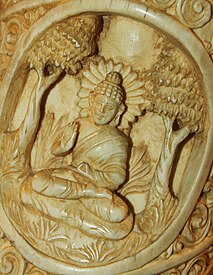 Budhha in Abhaya mudra
Budhha in Abhaya mudra
Post Enlightenment Life Events of Buddha
-
 Buddha visits his five old friends, who became the first disciples: Post his enlightenment, Buddha decided to first teach Dharma to his five friends who were his companions during his ascetic practices at Bodh Gaya. His five friends were Kondanna, Bhaddiya, Vappa, Mahanama and Assaji. Buddha went to Sarnath to meet them. For the first time he taught the Four Noble Truths and the Eightfold Path.
Buddha visits his five old friends, who became the first disciples: Post his enlightenment, Buddha decided to first teach Dharma to his five friends who were his companions during his ascetic practices at Bodh Gaya. His five friends were Kondanna, Bhaddiya, Vappa, Mahanama and Assaji. Buddha went to Sarnath to meet them. For the first time he taught the Four Noble Truths and the Eightfold Path. -
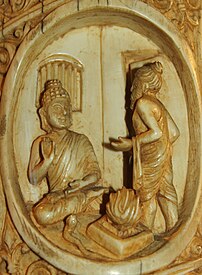 Buddha conquers the Agni-Pujaka Jatadhari Kasyapa
Buddha conquers the Agni-Pujaka Jatadhari Kasyapa -
 Buddha addressing the masses
Buddha addressing the masses -
 Buddha walking with a shepherd, holding a lamb
Buddha walking with a shepherd, holding a lamb -
![Magadh King welcoming Buddha: Buddha found patronage in emperor Bimbisāra. The emperor accepted Buddhism as his personal faith and allowed the establishment of many Buddhist vihāras. This eventually led to the renaming of the entire region as Bihār.[8]](//upload.wikimedia.org/wikipedia/commons/thumb/9/9d/Bimbisar_welcoming_Buddha_Roundel_30_buddha_ivory_tusk.jpg/205px-Bimbisar_welcoming_Buddha_Roundel_30_buddha_ivory_tusk.jpg)
-
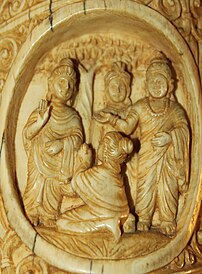 Śāriputra and Maudgalyayana become the followers of Buddha
Śāriputra and Maudgalyayana become the followers of Buddha -
 Buddha helping the grieved mother to come out from her child's birth
Buddha helping the grieved mother to come out from her child's birth -
 Suddhodhana welcoming Buddha at Kapilavastu
Suddhodhana welcoming Buddha at Kapilavastu -
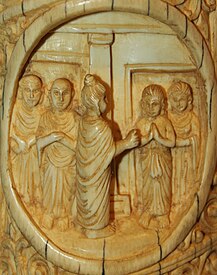 Buddha with Yasodhara and her son, Rahul
Buddha with Yasodhara and her son, Rahul -
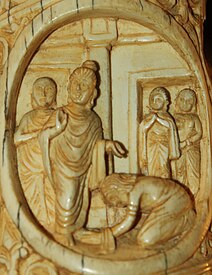 Buddha blesses Rāhula: On the advice of Yashodhara, Rāhula asked Buddha for his "inheritance". The Buddha called the venerable Sariputta and asked him to ordain Rāhula who became the first Sāmanera (novice monk). After Rāhula's ordination the Buddha taught him the importance of telling the truth. Buddha placed truth as the highest of all virtues. Rāhula subsequently became an arhant.
Buddha blesses Rāhula: On the advice of Yashodhara, Rāhula asked Buddha for his "inheritance". The Buddha called the venerable Sariputta and asked him to ordain Rāhula who became the first Sāmanera (novice monk). After Rāhula's ordination the Buddha taught him the importance of telling the truth. Buddha placed truth as the highest of all virtues. Rāhula subsequently became an arhant. -
 Amrapali, famous courtesan, greeting Buddha: Buddha while visiting Vaishali stayed at Amrapalli's mango grove. She invited Buddha for a meal which he accepted. She later donated the mangrove to his order. She accepted the Buddhist way, and remained an active supporter of the Buddhist order.
Amrapali, famous courtesan, greeting Buddha: Buddha while visiting Vaishali stayed at Amrapalli's mango grove. She invited Buddha for a meal which he accepted. She later donated the mangrove to his order. She accepted the Buddhist way, and remained an active supporter of the Buddhist order. -
 Ladies from the palace watch Buddha preaching
Ladies from the palace watch Buddha preaching -
 Nanda before Buddha
Nanda before Buddha -
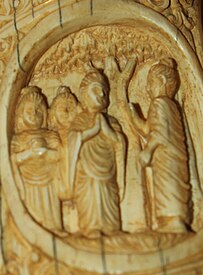 Buddha stops Nanda, who tried to escape from the Sangha
Buddha stops Nanda, who tried to escape from the Sangha -
 A mad elephant rushes towards Buddha
A mad elephant rushes towards Buddha -
 Buddha tames the mad elephant
Buddha tames the mad elephant -
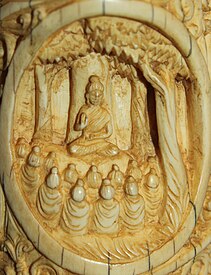 Buddha speaks to a large gathering
Buddha speaks to a large gathering -
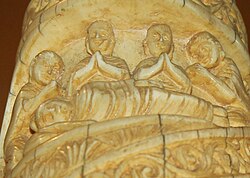 Mahaparinirvana of Buddha
Mahaparinirvana of Buddha
Buddha and Mudras
-
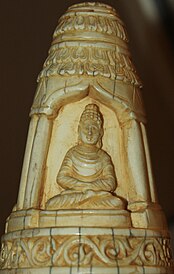 Buddha in Dhyana mudra
Buddha in Dhyana mudra -
 Buddha in Abhayamudra
Buddha in Abhayamudra -
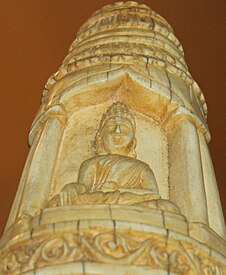 Buddha in Bhumisparsha mudra
Buddha in Bhumisparsha mudra
See also
References
- ^ "Decorative Arts Gallery at National Museum reopened". The Hindu. New Delhi. 6 July 2013. Retrieved 4 January 2014.
- ^ "British Museum - Ivory tusks carved with figures and cartoons". Archived from the original on 26 September 2015. Retrieved 15 June 2017.
- ^ Edwards, Owen (2008). "Spirals of History". Smithsonian Magazine.
- ^ Bhattacharyya, Asoke Kumar; Sengupta, Pradip Kumar (1991). Foundations of Indian Musicology: Perspectives in the Philosophy of Art and Culture. Abhinav Publications. p. 124. ISBN 9788170172734.
- ^ Pathak, Anamika (1997–98). "Carved Elephant Tusk Illustrating Buddha's Life". Kala- the Journal of Indian Art History Congress. IV. Guwahati: Indian Art History Congress.
- ^ Parimoo, R. (1982). Life of Buddha in Indian Sculpture. New Delhi. p. 11.
{{cite book}}: CS1 maint: location missing publisher (link) - ^ Beal, Samuel (1875). The Romantic Legend of Sâkya Buddha: From the Chinese-Sanscrit. New Delhi: Trübner & Company. p. 63. Retrieved 5 January 2014.
Romantic legends of sakya buddha.
- ^ India by Stanley Wolpert (Page 32)




![Mayadevi with her son Siddharatha This scene depicts the birth of Siddhartha, Prince of Kapilavastu in a different manner from other literary and sculptural narrations. Here Queen Mayadevi is shown seated with a baby in her lap surrounded by cauri-bearer and friends.[6]](http://upload.wikimedia.org/wikipedia/commons/thumb/5/56/Maya_Devi_with_her_son_Siddhartha_Roundel_6_buddha_ivory_tusk.jpg/209px-Maya_Devi_with_her_son_Siddhartha_Roundel_6_buddha_ivory_tusk.jpg)

![Mayadevi's death scene[7]](http://upload.wikimedia.org/wikipedia/commons/thumb/c/cf/Maya_Devi_on_her_death_bed_with_Suddhodhana_Roundel_8_buddha_ivory_tusk.jpg/214px-Maya_Devi_on_her_death_bed_with_Suddhodhana_Roundel_8_buddha_ivory_tusk.jpg)






















![Magadh King welcoming Buddha: Buddha found patronage in emperor Bimbisāra. The emperor accepted Buddhism as his personal faith and allowed the establishment of many Buddhist vihāras. This eventually led to the renaming of the entire region as Bihār.[8]](http://upload.wikimedia.org/wikipedia/commons/thumb/9/9d/Bimbisar_welcoming_Buddha_Roundel_30_buddha_ivory_tusk.jpg/205px-Bimbisar_welcoming_Buddha_Roundel_30_buddha_ivory_tusk.jpg)



























